Joseph Smith said, “Let man first get rid of his destructive propensities and then we may look for a change in the serpents’ disposition.” This is one of the reasons we love going to the temple.

“Nephi’s building of the temple was to bless the lives of his people. Elder Maxwell explained the significance of temple worship in our day when he said, “The real act of personal sacrifice is not now nor ever has been placing an animal on the altar. Instead, it is a willingness to put the animal that is in us upon the altar—then willingly watching it be consumed! Such is the ‘sacrifice unto [the Lord of] a broken heart and a contrite spirit.’ (3 Nephi 9:20).” Neal A Maxwell, Meek and Lowly 1987. Joseph Smith during Zion’s Camp, stopped some men from killing rattlesnakes and then said, “…Let man first get rid of his destructive propensities and then we may look for a change in the serpents’ disposition.” The Prophet Joseph Smith also taught us about faith and sacrifice saying, “A religion that does not require the sacrifice of all things never has power sufficient to produce the faith necessary unto life and salvation; for, from the first existence of man, the faith necessary unto the enjoyment of life and salvation never could be obtained without the sacrifice of all earthly things.” Joseph Smith Jr. Lectures on Faith. President Ezra Taft Benson succinctly restated the message of Abraham 3:25 when he said: “The great test of life is obedience to God… We are not here to test or “prove” God, but to be tested and proved ourselves. We are on trial, not God.” Ensign, May 1988.
Nephi ordained his brother Jacob and others to teach in the temple. Jacob 1:17. Nephi knew his people needed the greater light that a temple would provide. Nephi’s faith is a great example to us all of passing this important test of life, and the building of the first Nephite temple was a sign to all, of his devotion to the Great Jehovah.
Here I discuss the importance of the Temple and the importance of where it is placed and why. There is a reason you and I love the beauty of being on the mountain tops.” Rian Nelson
D&C 124:25–27. “Build a House to My Name for the Most High to Dwell Therein”
The building of the Nauvoo Temple was the fifth attempt by the Latter-day Saints to build a house of the Lord. The other attempts include Jackson County, Missouri; Kirtland, Ohio; and Far West and Adam-ondi-Ahman, Missouri. Only the Kirtland Temple was completed before the one in Nauvoo, and it was desecrated, as Brigham Young explained: “The Saints had to flee before mobocracy. And, by toil and daily labor, they found places in Missouri, where they laid the corner stones of Temples, in Zion and her Stakes, and then had to retreat to Illinois, to save the lives of those who could get away alive from Missouri, where fell the Apostle David W. Patten, with many like associates, and where were imprisoned in loathsome dungeons, and fed on human flesh, Joseph and Hyrum, and many others. But before all this had transpired, the Temple at Kirtland had fallen into the hands of wicked men, and by them been polluted, like the Temple at Jerusalem, and consequently it was disowned by the Father and the Son.” (In Journal of Discourses, 2:32.)https://www.churchofjesuschrist.org/manual/doctrine-and-covenants-student-manual/section-124-a-solemn-proclamation-the-priesthood-order-is-established?lang=eng

D&C 124:28. What Is Meant by “The Fulness of the Priesthood”?
President Joseph Fielding Smith wrote:
“Joseph Smith said … , ‘If a man gets a fulness of the Priesthood of God, he has to get it in the same way that Jesus Christ obtained it, and that was by keeping all the commandments and obeying all the ordinances of the house of the Lord.’ [History of the Church, 5:424.]
I hope we understand that. If we want to receive the fullness of the Priesthood of God, then we must receive the fullness of the ordinances of the house of the Lord and keep His commandments. …

Let me put this in a little different way. I do not care what office you hold in this Church, you may be an apostle, you may be patriarch, a high priest, or anything else, and you cannot receive the fulness of the Priesthood unless you go into the temple of the Lord and receive these ordinances of which the Prophet speaks. No man can get the fulness of the Priesthood outside of the temple of the Lord. There was a time when that could be done, for the Lord could give these things on the mountain tops—no doubt that is where Moses got it, that is no doubt where Elijah got it—and the Lord said that in the days of poverty, when there was no house prepared in which to receive these things, that they can be received on the mountain tops. But now you will have to go into the house of the Lord, and you cannot get the fulness of the priesthood unless you go there. (Elijah the Prophet, pp. 45–46.)” Joseph Fielding Smith
What’s Going on in the Book of Mormon Isaiah Chapters?
Here Are 3 Insights into the Verses
by Tammy Uzelac Hall
Question: Isaiah 2:2 and 2 Nephi 12:2 say that the mountain of the Lord’s house shall be established in the top of the mountains. What exactly does this mean?
Answer: Mountains were among the first places where God would commune with and teach His people His ways—they were essentially temples. Here are a few examples of people in the scriptures who communed with God on mountains:
- Moses on Mount Sinai (Exodus 3)
- Peter, James, and John on the Mount of Transfiguration (2 Peter 1:16–19; Doctrine and Covenants 131:5)
- The Brother of Jared on Mount Shelem (Ether 3:1)
- Enoch on Mount Simeon (Moses 7:2)
- Nephi on an unnamed mountain (1 Nephi 11:1)

The experiences the prophets had on the tops of mountains held great significance. It was here that Moses received the call to deliver Israel. It was here that Nephi received the interpretation of his father’s dream, and where the Brother of Jared saw the finger of the Lord.
In New Testament times, it appears that Peter, James, and John all received their endowment while on the Mount of Transfiguration [See Joseph Fielding Smith, Doctrines of Salvation, comp. Bruce R. McConkie, 3 vols. (1954–56), 2:165]. While on the mount, they received the more sure word of prophecy when it was revealed to them that they were sealed up unto eternal life (2 Peter 1:16–19; Doctrine and Covenants 131:5). Source Editor’s Note: Tammy Uzelac Hall is the host of LDS Living’s Sunday on Monday
Another example of how mountains are similar to temples is from more recent Church history, as you will read below about Pioneer Addison Pratt
Ensign Peak

“From the time the pioneers first entered the Salt Lake Valley until the present, Ensign Peak has received recognition beyond its geological importance. The peak is best described as an undistinguished hill, rising over a thousand feet from the northern edge of the Salt Lake Valley, approximately one mile north of the Utah State Capitol Building. While unremarkable in most ways, the peak has received attention from community and religious leaders because of its historical importance.” Ensign Peak: A Historical Review Dennis A. Wright and Rebekah E. Westrup
How one Utah hill became a Mormon temple — for a day
“History • Ensign Peak provided the backdrop for several well-known early Salt Lake City events, but it also played host to the first LDS temple ordinance in Utah.
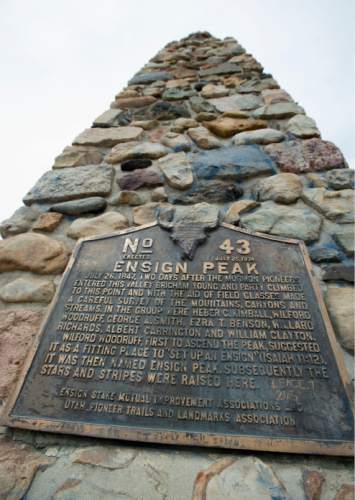


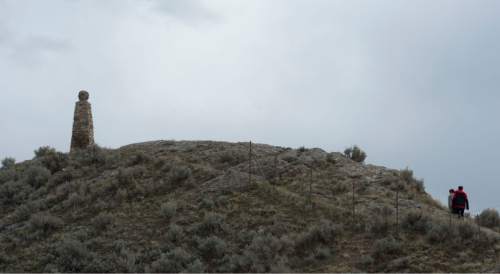
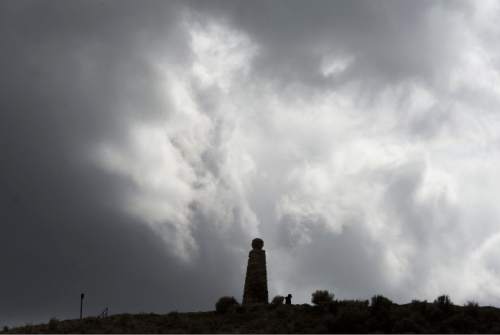
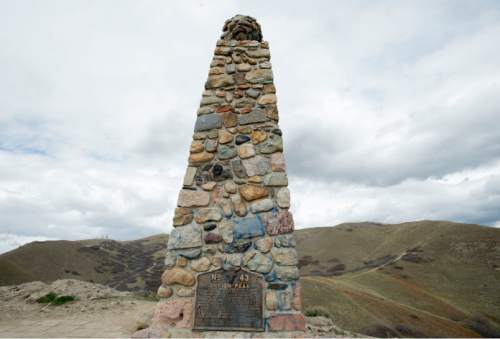
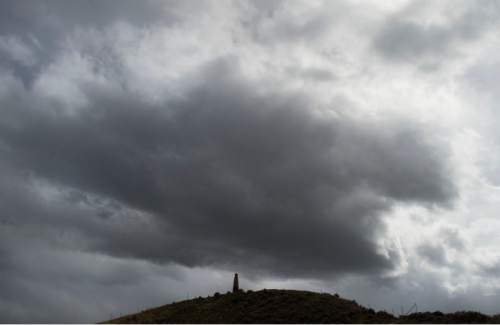



Jutting up like a rounded brown thumb a mile north of the Utah Capitol, Ensign Peak boasts a unique claim: This humble hill once served as a Mormon temple — at least for one day and for one person.
Many of the crowds flocking to LDS General Conference this weekend will visit some of the 14 other Mormon temples in the Beehive State (with three more planned or under construction). Few may realize that the hill north of downtown Salt Lake City played host to the first LDS temple ordinance performed in Utah.
The peak has much other historical significance, too, ranging from Brigham Young proclaiming he saw it in a vision as the hill beneath which Mormon pioneers should settle to an LDS belief that the site represents fulfillment of biblical prophecy.
Ensign Peak’s history as a temple is unusual because The Church of Jesus Christ of Latter-day Saints normally reserves its most sacred sacraments — including eternal marriage — for specially designed and dedicated buildings.

One of those temple ceremonies is called the endowment, a word meaning gift. The church’s website says that “as part of this ordinance, we are taught about the purpose of life, the mission and atonement of Jesus Christ and Heavenly Father’s plan for his children. We gain a glimpse of what it will be like to live in his presence.”
Before mobs forced Mormons to flee Nauvoo, Ill., members crowded an early LDS temple there to receive the endowment before trekking westward toward Utah.
To show the importance of temples, Young designated the site for the Salt Lake Temple just days after he arrived in the Salt Lake Valley. But that iconic temple would not be completed for 46 years. Other Utah temples would be finished before that in St. George, Logan and Manti, but they still were decades away.

Meanwhile, Addison Pratt missed the opportunity to receive his endowment in Nauvoo because he was away as a missionary in the South Pacific. In 1849, he was about to leave again on a mission to the Society Islands, or French Polynesia. He and LDS leaders wanted him to receive that ordinance before he left, and Ensign Peak essentially became a temple for the purpose.
Minutes of the event — published in the book “The Development of LDS Temple Worship 1846-2000” — record that on July 21, 1849, Young, six members of the faith’s Quorum of the Twelve Apostles and other general authorities met atop the hill with Pratt at 6 a.m.
Young prayed and “consecrated the spot for the present purpose of giving … Pratt his endowment that we might have power to erect a standard that should be glorified in the eyes of all its beholders, that no unholy thing might come here, that thy servants may come here to offer up prayers and obtain the ministration of angels.”

LDS historian B.H. Roberts wrote that the “action was in harmony with the instructions of the Prophet [LDS Church founder Joseph Smith] in Nauvoo when he said that these ordinances of the temple under certain circumstances might be obtained on the mountaintop, as Moses obtained them.”
Devery S. Anderson, editor of “The Development of LDS Temple Worship,” wrote that Pratt’s endowment is the only one documented to have occurred on Ensign Peak.
Other endowments would be performed before permanent Mormon temples were up and running in the Salt Lake Valley, according to the book, including in an early Salt Lake City building called the Council House (which later burned down) and a temporary temple dubbed the Endowment House on Temple Square.
Pratt, originally a whaler from New England, served several LDS missions, including the faith’s first foreign-language mission (he had learned Hawaiian as a young sailor). For a short time, he offered classes in Utah to teach Tahitian to other potential proselytizers, essentially operating the church’s first language training center for missionaries.
Among other historical highlights for Ensign Peak, George A. Smith — a counselor to Young — said that Mormonism’s second prophet saw the hill in a vision and was told LDS pioneers should settle beneath it, according to Dennis Wright and Rebekah Westrup, who wrote a chapter about the hill’s history in “Salt Lake City: The Place Which God Prepared.”
George A. Smith said Young recognized the hill when he arrived in the valley because of that vision.
Young climbed Ensign Peak two days after he arrived in the valley with other leaders and began planning the new settlement using the view from that hilltop.
Wilford Woodruff, an early apostle who later led the LDS Church, suggested while there — according to a plaque on the peak — that it was a fit place “to set up an ensign” to fulfill Isaiah 11:12.
That Bible passage proclaims, “And he shall set up an ensign for the nations, and shall assemble the outcasts of Israel, and gather together the dispersed of Judah from the four corners of the earth.”

A Mormon hymn, “High on the Mountain Top,” was written by Joel Johnson and inspired by Ensign Peak, along with other Isaiah prophesies saying that “the mountain of the Lord’s house shall be established in the top of the mountains, and shall be exalted above the hills; and all nations shall flow unto it” in the last days (Isaiah 2:2).
Wright and Westrup wrote that the current monument and flagpole atop the hill was built in 1934, and included stones gathered from the Mormon Pioneer Trail and various LDS historical sites, including the Sacred Grove in New York (where founder Smith said he saw God).
A public trail up to the peak, with a monument garden at its base, starts off Ensign Vista Drive in Salt Lake City. Utah LDS temples and dedication dates
St. George, 1877.
Logan, 1884.
Manti, 1888.
Salt Lake, 1893.
Ogden, 1972, rededicated 2014.
Provo, 1972.
Jordan River (South Jordan), 1981.
Bountiful, 1995.
Mount Timpanogos (American Fork), 1996.
Vernal, 1997
Monticello, 1998.
Draper, 2009.
Oquirrh Mountain (South Jordan), 2009.
Brigham City, 2012.
Payson, scheduled for June 7.
Provo City Center (formerly the Provo Tabernacle), under construction.
Cedar City, announced. —
“What is the LDS endowment?
Mormons go to temples to take part in “endowment” ordinances for themselves and for people who have died. The symbolic ceremony includes ritual re-enactments of the creation, Adam and Eve’s expulsion from the Garden of Eden and humankind’s mortal journey and ultimate return to God’s presence. In the Salt Lake and Manti temples, live actors portray these scenes. But in all other Mormon temples, the story is told through films. During the ceremony, LDS temple goers make promises to the Almighty to act, speak and think according to heaven’s commands.”
Sources: Encyclopedia of Mormonism, lds.org — Peak prophecy
“And he shall set up an ensign for the nations, and shall assemble the outcasts of Israel, and gather together the dispersed of Judah from the four corners of the earth.” Isaiah 11:12″
https://archive.sltrib.com/article.php?id=2298685&itype=CMSID






